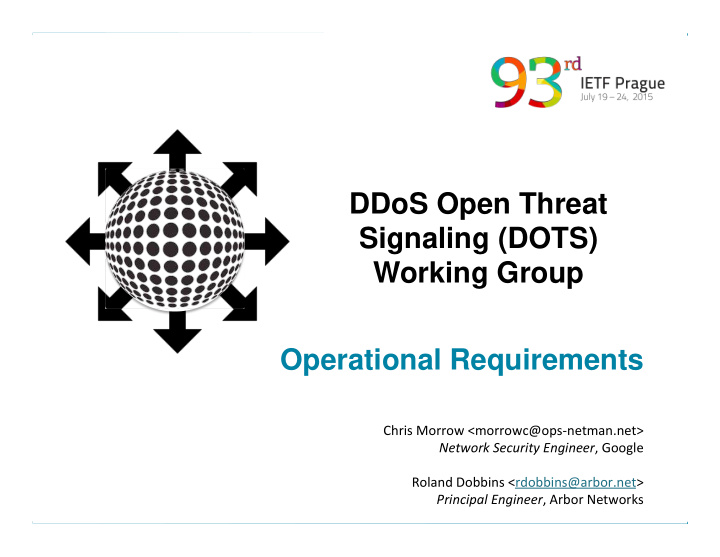



DDoS Open Threat Signaling (DOTS) Working Group Operational Requirements Chris ¡Morrow ¡<morrowc@ops-‑netman.net> ¡ Network ¡Security ¡Engineer , ¡Google ¡ ¡ Roland ¡Dobbins ¡<rdobbins@arbor.net> ¡ Principal ¡Engineer , ¡Arbor ¡Networks ¡ DOTS WG
IntroducDon ¡& ¡Context ¡ DOTS WG 2 ¡
DDoS Background What is a D istributed D enial o f S ervice (DDoS) attack? • An attempt to consume finite resources , exploit weaknesses in software design or implementation, or exploit lack of infrastructure capacity • Targets the availability and utility of computing and network resources • Attacks are almost always distributed for even more significant effect (i.e., DDoS) • The collateral damage caused by an attack can be as bad, if not worse, than the attack itself • DDoS attacks affect availability ! No availability, no applications/services/ data/Internet! No revenue! • DDoS attacks are attacks against capacity and/or state ! DOTS WG
Three Security Characteristics Availability ¡ Confiden'ality ¡ Integrity ¡ • The goal of security is to maintain these three characteristics DOTS WG
Three Security Characteristics Availability ¡ Confiden'ality ¡ Integrity ¡ • The primary goal of DDoS defense is maintaining availability in the face of attack DOTS WG
ReflecDon/AmplificaDon ¡ RealiDes ¡of ¡Coordinated ¡ DDoS ¡ALacks ¡ DDoS ¡Defense ¡ DOTS WG 6 ¡
Common Perception of Internet Security Posture Today DOTS WG 7 ¡
Actual State of Internet Defenses Today DOTS WG 8 ¡
Who Can Help? Your ISP or MSSP! DOTS WG 9 ¡
How Can You Ask for Help Today? Technology pioneered by Robert Hooke in 1667, only slightly improved! DOTS WG 10 ¡
Asking for Help is Hard! Knowing How to Help is Harder! • Most end-customers have no idea what their normal Internet traffic looks like, much less what’s actually happening when they’re being DDoSed (or even understanding that they’re under attack!). • Many ISPs/MSSPs do not provision DDoS defenses in detail for their end-customers . In many (most?) cases, end- customers cannot articulate what servers/services need protection, what network access policies should be in place, etc. • This drastically slows reaction/mitigation times. • This drastically impedes reaction/mitigation efficacy. • This leads to extended outages, lost revenue, frustrated end-customers (and customers of those end-customers). DOTS WG 11 ¡
Automated DDoS Attack Notification Methods Exist Today • But they are proprietary! • End-customers can’t mix-and-match vendors, ISP DDoS cloud mitigation providers, MSSP DDoS cloud mitigation providers. Effective coordination during an attack is for all practical purposes impossible . • Servers/services/infrastructure devices which are the targets of DDoS can’t signal for mitigation, even if they have the ability to detect and classify DDoS attacks (think Apache mod_security/mod_evasive, BIND RRL). • ISPs/MSSPs must coordinate (badly, inefficiently) manually when jointly working to mitigate DDoS attacks. • As attackers shift DDoS vectors/resources, severe latency, common miscuing occurs between defenders. • Web portals exist; they’re specific to vendors/ISPs/MSSPs, have varying degrees of mitigation configurability (most end-customers wouldn’t know what to configure), and can be difficult to access during an attack when IDC & client LAN transit are conflated. DOTS WG 12 ¡
DDoS Defense Becomes a Typing Contest . . . Attacker. DOTS WG 13 ¡
DDoS Defense Becomes a Typing Contest . . . Defender. DOTS WG 14 ¡
Largely Static, Low-Agility Defenses . . . DOTS WG 15 ¡
. . . Lead to Predictable Outcomes. DOTS WG 16 ¡
Coordination of DDoS Defenses, Circa 1995. DOTS WG 17 ¡
Coordination of DDoS Defenses, Circa 2005. DOTS WG 18 ¡
Coordination of DDoS Defenses, Circa 2015. DOTS WG 19 ¡
We Can – and Must – Do Better Than This! DOTS WG 20 ¡
We Need a Standardized Way of Sharing Information . . . DOTS WG 21 ¡
. . . Across a Fast, Low-Latency, Unreliable Transport . . . DOTS WG 22 ¡
. . . Across a Reliable Transport That Will Make It Through Policies . . . DOTS WG 23 ¡
. . . Tell Us About Itself, Its Problems, and Its Desired Actions. . . DOTS WG 24 ¡
. . . That Can Be Relayed Internally and Externally as Needed . . . DOTS WG 25 ¡
. . . Everyone and Everything on the Network Can Participate . . . DOTS WG 26 ¡
. . . In Coordinated, On-Demand DDoS Defense. DOTS WG 27 ¡
Summary ¡of ¡DOTS ¡ OperaDonal ¡Requirements ¡ DOTS WG 28 ¡
DOTS Operational Requirements • Standards-based exchange of DDoS attack and mitigation information. • Must not assume organic detection/ classification capabilities of supplicant. • Must work across common unreliable and reliable transports. • Must support mutual authentication and optional crypto. DOTS WG 29 ¡
DOTS Operational Requirements (cont.) • Must describe target under attack (IP address range, ports/protocols/services running on target, etc.). • Must describe desired outcome in general terms (block, redirect, scrub, rate-limit, etc.). • Must update supplicant with implemented actions and status, supplicant must do same. • Must support intra- and inter-organizational relays. DOTS WG 30 ¡
DOTS Operational Requirements (cont.) • Must support policy-based action/outcome filtering and transformation. • Must be extensible. • Must focus on DDoS initially, other uses can come later. • Must minimize complexity of implementation and node interaction. DOTS WG 31 ¡
DOTS Operational Requirements (cont.) • Must include a ‘heartbeat’ function. • Must be detection/classification/mitigation- technology agnostic. • Must support allowed distribution scope (TLP?). • Should utilize existing protocols and information models wherever possible and whenever appropriate. DOTS WG 32 ¡
This Presentation – http://bit.ly/1I2IVrF DOTS WG
DDoS Open Threat Signaling (DOTS) Working Group Thank You! Chris ¡Morrow ¡<morrowc@ops-‑netman.net> ¡ Network ¡Security ¡Engineer , ¡Google ¡ ¡ Roland ¡Dobbins ¡<rdobbins@arbor.net> ¡ Principal ¡Engineer , ¡Arbor ¡Networks ¡ DOTS WG
Recommend
More recommend